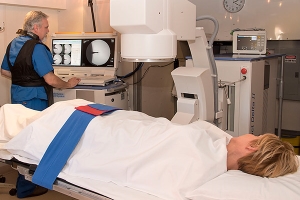 Lithotripsy is a procedure used to treat kidney stones that are too large
to pass through the urinary tract. It works by sending focused ultrasound
energy or shock waves directly to the stone. The shock waves breakup a
large kidney stone so that it will pass through the urinary system. Lithotripsy
lets people with certain types of kidney stones avoid surgery.
Lithotripsy is a procedure used to treat kidney stones that are too large
to pass through the urinary tract. It works by sending focused ultrasound
energy or shock waves directly to the stone. The shock waves breakup a
large kidney stone so that it will pass through the urinary system. Lithotripsy
lets people with certain types of kidney stones avoid surgery.
When substances normally excreted through the kidneys stay in the kidney,
they may crystallize and harden into a kidney stone. If the stones break
free, they can get stuck in, the narrower passages of the urinary tract.
Some kidney stones are small or smooth enough to pass easily through the
urinary tract without discomfort. Other stones may have rough edges or
grow as large as a pea. These can cause great pain as they move through
or stick in the urinary tract. The areas that are more prone to trapping
kidney stones are the bladder, ureters, and urethra.
“Since lithotripsy services were introduced at CVMC in 1989, we’ve
grown to treat about 300 patients a year at CVMC,” says Bruce Billington,
Coordinator of Lithotripsy.
What happens during lithotripsy? Lithotripsy services at CVMC are provided on an outpatient basis. Generally,
lithotripsy follows this process:
- After the stone(s) has been found with fluoroscopy, you will be positioned
for the best access to the stone.
- Patient is anesthetized during the procedure and feels no pain
- A series of shock waves will be sent to shatter the kidney stone(s).
- The stone(s) will be monitored by fluoroscopy during the procedure.
- Once the stone fragments are small enough to pass through the urinary system,
the procedure will end.
After lithotripsy you will be taken to the recovery area for observation.
Once your blood pressure, pulse, and breathing are stable and you are
alert, you will be discharged home. Plan to have someone give you a ride
home. You should not drive for at least 24 hours after getting sedatives
for the procedure. Your healthcare provider will provide specific post
procedure instructions that often include:
- When to resume your usual diet and activities
- You will be encouraged to drink extra fluids to dilute the urine and reduce
the discomfort of passing stone pieces
- You may notice blood in your urine for a few days or longer after the procedure.
This is normal
- You may notice bruising on the back or belly. This is also normal
- Take a pain reliever for soreness as recommended by your healthcare provider.
Avoid aspirin or certain other pain medicines. They may increase the chance
of bleeding. Be sure to take only recommended medicines
- You may be given antibiotics after the procedure. Be sure to take the medicine
exactly as prescribed
- You may be asked to strain your urine so that remaining stones or stone
pieces can be sent to the lab for testing
- A follow-up appointment will be scheduled within a few weeks after the
procedure. If a stent was placed, it may be removed at this time
How you can minimize recurring kidney stones:
People who have had one kidney stone are prone to develop others. Without
preventive treatment or changes in lifestyle, patients can develop a new
stone. About 80% of patients develop additional stones and half of these
do so within 5 to 10 years of the first stone. If you have had kidney
stones before, you are more likely to have kidney stones again. To help
keep future stones from forming, try to:
- Drink 6 to 8 glasses of water each day
- Eat less salt (sodium), meat and eggs
- Talk to your doctor about medications and other tests for kidney stones
What should you do if you think you have a kidney stone?
If you are having symptoms of a kidney stone, see your healthcare provider
at your earliest convenience.